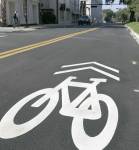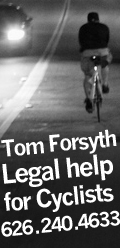Bike Paths not Worthy of Federal Support, says current U.S. Transportation Secretary

Thread started by
Sir Terrence Tuppins at 09.13.07 - 6:42 pm
http://www.salon.com/news/feature/2007/09/14/bike_paths/
---------------------------------------------------
Bike activists face an uphill climb against Transportation Secretary Mary Peters, who claims bike paths are not transportation and are stealing tax money from bridges and roads.
By Katharine Mieszkowski
Sept. 14, 2007
Imagine you're the federal official in the Bush administration charged with overseeing the nation's transportation infrastructure. A major bridge collapses on an interstate highway during rush hour, killing 13 people and injuring an additional 100. Whom to blame? How about the nation's bicyclists and pedestrians!
The Minneapolis bridge collapse on Aug. 1 led Secretary of Transportation Mary Peters to publicly reflect on federal transportation spending priorities and conclude that those greedy bicyclists and pedestrians, not to mention museumgoers and historic preservationists, hog too much of the billions of federal dollars raised by the gas tax, money that should go to pave highways and bridges. Better still, Peters, a 2006 Bush appointee, apparently doesn't see biking and walking paths as part of transportation infrastructure at all.
In an Aug. 15 appearance on PBS's "NewsHour With Jim Lehrer," Peters spoke against a proposal to raise gas taxes to shore up the nation's aging infrastructure. The real problem, the secretary argued, is that only 60 percent of the current money raised by gas taxes goes to highways and bridges. She conveniently neglected to mention that about 30 percent of the money goes to public transit. She then went on to blast congressional earmarks, which dedicate 10 percent of the gas tax to some 6,000 other projects around the country. "There are museums that are being built with that money, bike paths, trails, repairing lighthouses. Those are some of the kind of things that that money is being spent on, as opposed to our infrastructure," she said. The secretary added that projects like bike paths and trails "are really not transportation."
Peters' comments set off an eruption of blogging, e-mailing and letter-writing among bike riders and activists, incensed that no matter how many times they burn calories instead of fossil fuels with the words "One Less Car" or "We're Not Holding Up the Traffic, We Are the Traffic" plastered on their helmets, their pedal pushing is not taken seriously as a form of transportation by the honchos in Washington, D.C.
Bike paths are not infrastructure? "There are hundreds of thousands of people who ride to work, and millions who walk to work every day, and the idea [that] that isn't transportation is ludicrous," says Andy Clarke, executive director of the League of American Bicyclists, who has biked to work for almost 20 years on a path paid for with federal dollars. Clarke fired off an angry letter to Peters, and invited the 25,000 members of his organization around the country to do the same. "The guy in his Humvee taking his videos back to the video store isn't any more legitimate a trip than the guy on the Raleigh taking his videos back," says Andy Thornley, program director for the San Francisco Bicycle Coalition.
In fact, only about 1.5 percent of federal transportation dollars go to fund bike paths and walking trails. In the meantime, 10 percent of all U.S. trips to work, school and the store occur on bike or foot, and bicyclists and pedestrians account for about 12 percent of annual traffic fatalities, according to the Federal Highway Administration. "We represent a disproportionate share of the injuries, and we get a minuscule share of the funds," says Robert Raburn, executive director of the East Bay Bike Coalition in the San Francisco Bay Area, who calls the Peters' comments "outrageous." Plus, he notes, with problems like global warming, the obesity epidemic and energy independence, shouldn't the U.S. secretary of transportation be praising biking, not complaining about it?
What really drives cyclists around the bend is that while they're doing their part to burn less fossil fuel -- cue slogan: "No Iraqis Died to Fuel This Bike" -- they're getting grief for being expensive from a profligate administration. "War spending, tax cuts for the rich, and gas taxes are all big sources of funding. Bike spending is not," fumes Michael Bluejay, an Austin, Texas, bike activist, in an e-mail. "The few pennies we toss toward bike projects is not enough to fix our nation's bridges, not by a freaking long shot."
One of the many communities that benefit from federal dollars for bicyclists and pedestrians is the very one where the bridge collapsed. For the St. Paul, Minn., program Bike/Walk Twin Cities, administered by Transit for Livable Communities, $21.5 million of federal dough is being spent to create bike lanes, connect existing walking and biking trails with one another, and install signage to alert drivers of the presence of bicyclists and walkers. Despite the cold winters, Minneapolis is something of a biking Mecca, with 2.4 percent of all trips to work made by bike, significantly higher than the national average of 0.4 percent, according to Joan Pasiuk, program director of Bike/Walk Twin Cities.
It's hard to argue that walking paths and bike trails are robbing federal coffers when states can't even spend all the federal money they've received to repair bridges in the first place. In 2006, state departments of transportation sent back $1 billion in unspent bridge funds to the federal government, according to the Federal Highway Administration. "The fact that there is a billion dollars of bridge repair money sloshing around in the system not being spent suggests that it's not the fault of bike trails," says Clarke.
Congressional Democrats agree. "It's a red herring to point to bike paths and even imply that if we didn't build another bike path we'd have all the money we need to fix our highways and bridges," says Jim Berard, communications director for the House Committee on Transportation and Infrastructure. "You can't build very many bridges with the amount of money that you would save if you didn't build any bike paths."
So why is Peters suddenly taking on bikes and pedestrians? Her comments are especially odd since she sang the praises of bikes as transportation in a speech at the National Bike Summit in Washington, in March 2002. Has she simply forgotten the glory of two wheels? One theory: Peters is on a campaign to quash the idea of raising the gas tax, as she editorialized recently in the Washington Post. A key proponent of raising the gas tax to fund bridge restorations in the wake of the Minneapolis bridge collapse is Democratic Rep. Jim Oberstar of Minnesota, who has advocated for bike and pedestrian paths in his district. By putting a culture-war spin on the bridge collapse, Peters is hoping to run his gas tax proposal off the road.
Does Peters herself buy this theory? Does she really think that bike paths do not qualify as transportation infrastructure? Why does she say that things like bike paths steal money from bridge repairs when states have more than enough money to fix bridges? The secretary would not respond, but Jennifer Hing, a spokesperson for the Department of Transportation's Office of Public Affairs in the Office of the Secretary, would. She answered all the specific questions with one resoundingly uninformative e-mail: "The federal government should set high standards for and invest in the ongoing safety, reliability and interconnection of the nation's transportation network. State and local communities should have the flexibility to then set local transportation priorities."
For their part, cyclists have been weaving through political land mines for decades. In the perennial struggle to gain public support for bike paths, they remain philosophical. Says Thornley of the San Francisco Bicycle Coalition: "Before there were automobiles, and after there will be automobiles, there will be bicycles moving people around for transportation."
reply
MAKE THE CALLS AND EMAILS:
http://www.dot.gov/contact.html
"Please send your suggestions, comments or questions, as well as messages for the Secretary and other Department of Transportation officials, to dot.comments@dot.gov
A team of information specialists answer every message sent from this home page. The information specialists process mail Monday-Friday (7:30 a.m. - 5:00 p.m. Eastern Time), except on federal holidays. Mail sent late Friday or over the weekend will not be reviewed until the following Monday. We try to respond to you within 4 business days.
Correspondence to the Department may be sent to:
U.S. Department of Transportation
1200 New Jersey Ave, SE
Washington, DC 20590"
 Roadblock
Roadblock09.13.07 - 8:30 pm
reply
I think that what this lady said is bullshit, HOWEVER, bike lanes in L.A. cost $1 million per mile!
That is expensive!
My info is mostly based on bicycle-advocate hearsay, but still - that is a lot of money. Also, given how cars are the only user group that gets counted by our nation's transportation/traffic engineers - is it any surprise that pedestrians and cyclists are seen as a "waste"?
The reality is that we could save ourselves a lot of money if we shifted our transportation network over to more diverse user groups - like cyclists and pedestrians. Automobile use would have to be de-emphasized - but then, so would the costs of maintaining our transportation network. Our transportation would be less dependent on the vagaries of the international oil trade, our locally owned neighorhood shops would thrive, and the value of land and the quality of life in cities would only increase around areas that facilitate walking and bicycling - all of this at the same time that we would save hundreds of millions of dollars a year by not having to service and repair roads that get demolished by automobiles.
 ubrayj02
ubrayj0209.14.07 - 11:10 am
reply

This is a job for ... CAPTAAAAAIN SHAARROW!
 Joe Borfo
Joe Borfo09.14.07 - 11:28 am
reply
the last time captain sharrow did some work in Highland Park, his sharrows were painted over with black.
WTF!?!?
the city can pay to have them painted over, but they can't pay to stencil a few sharrows?
 spiraldemon
spiraldemon09.14.07 - 11:32 am
reply

The real reality is C.R.E.A.M. Cash Rules Everything Around Me.
Everyone knows what the practical and intelligent answers are but no one knows how to fight money interests from accomplishing their agenda often in conflict with the public good. just gotta wait around until the system rots itself to death I guess....
 Roadblock
Roadblock09.14.07 - 12:09 pm
reply
how many everyday riders actually use bike paths? i ride almost every day and never use a bike path. if they didn't exist, i wouldn't even notice.
they seem to be good for weekend day riders and lengthy events such as the la river rides and century rides. but other than that, they're inconveniently located and restrictive. also, they're unsafe at night due to lack of lighting, broken glass and people walking around drunk in the middle of the path.
what about "bikes on the streets: it's the law." i think perhaps transferring the funding into locations cyclists actually use would be much more beneficial.
i'm ready for the heat...
 meandmybluebike
meandmybluebike09.14.07 - 12:16 pm
reply
living in Panorama City, I use bike paths pretty often. the orange line bike path takes me directly to the NoHo redline station, and I use the L.A. river path to get to downtown or Highland Park (where the Bike Oven is). I enjoy using both paths because it allows me to concentrate more on riding and less on cars. I especially like the L.A. river path because it has no stop lights. It's like a freeway for bikes. I see more cyclists on these paths than I do on the streets of the SFV, and most of them seem like noobs. I think it's a great way to encourage new riders to get out. Not everyone has the skills and knowledge to ride comfortably on the mean streets of L.A.
 spiraldemon
spiraldemon09.14.07 - 12:52 pm
reply
take one 7 day trip to the Netherlands and you will understand what real bicycle infrastucture is allll about. Bike lanes are absolutely essential, but bike paths are as well.
I LOVE bike paths. When I ride out to Northridge I am so thankful for the river path and the orange line bike path. It's so relaxing and care free not to have to worry about cars and peds.
In the Netherlands there are seperate bicycle highways that take you from city to city. Then you hop off those and ride on streets with well designed signage and street markings to get you around locally. It's the combination of the two that make it work really really well.
Here in LA we dont have the funding needed to maintain our bicycle highways and thats why there is glass and no lighting. if there were funding you would be singing the praises of the bike paths Annie. go check out the Orangeline bike path, it's pretty decent.
We need both.
and someone said it costs a Million dollars a mile for a fucking bike lane on the street?????
GIVE ME THE FUCKING CONTRACT. I WILL HANDLE IT MYSELF FOR THAT KINDA DOUGH.
 Roadblock
Roadblock09.14.07 - 1:02 pm
reply
The million per mile thing doesn't sound right at all. Especially since the road surface is already there...
All that's involved (other than planning of course) is the painting of the lines etc. Unless they use paint with gold flakes in it, I don't see how it could be that expensive.
 kyber
kyber09.14.07 - 1:19 pm
reply
Makes no sense to me either. Can we get some sources to back up that huge number?
 MIDI Lifestyle
MIDI Lifestyle09.14.07 - 1:23 pm
reply
you give me a Million Dollars and I will handle it for 3 miles. In fact I will be like that dude who paints the golden gate bridge every year that the tour guides talk about. Those will be the best god damned three miles of bike lane you ever saw! I'd even kick over valet signs and garbage cans for FREE
 Roadblock
Roadblock09.14.07 - 1:27 pm
reply
Roadblock - there is plenty of money out there to build a bicycle transportation network.
What is lacking is the political will and the education of the people of this area about the economic, quality of life, safety, and health benefits of having a bicycle transportation network.
As an example about how much money there is for this sort of thing: sales tax in L.A. is 8.25%
Every dollar that gets taxed in L.A. through sales tax has one cent taken out and sent to the MTA.
The MTA gets BILLIONS every year.
About why it costs $1 million bucks to make a bike lane:
Governments cannot hire a contractor to do some work the way you or me might hire someone to paint our house. They have to hire contractors using a huge and complicated set of rules that allegedly make the hiring process "fair" - union contractors, following best pratices, carrying enough insurance, etc.
Then, they have to make sure that the contractor can go without pay, sometimes for months or years, after the job is done. It can take a looong time to get money from a government agency that is unmotivated to get things done.
The cost of painting a good bike lane, in material and labor, is likely a few thousand dollars (maybe 10k) per mile - but the overhead is enormous.
Additionally, once a bike lane is built - nobody has any reliable measurements they apply to see if the facility is used, in good shape, and kept functional. There are not even measurements the LADOT or MTA uses to ensure that bikeways are functional. Bicycles are, by definition, NOT "traffic" or "transportation" in the CA DOT, MTA or LADOT policy manuals - so their net impact on travel (if any) is not even measured.
This transit secretary reflects the attitude of professional traffic engineers in this country. Take a look at the Institue for Transportation Engineers, and thei manual for roadway design. The only thing they care about, design, and measure, are car trips.
It is so beyond moral outrage - it's like we don't exist to these people. We don't count - they don't count us. Bicycles are not counted, and so there is no known way (to transit engineers in the U.S.) to improve our lot.
 ubrayj02
ubrayj0209.14.07 - 3:03 pm
reply
That's why we have Capt. Sharrow FTW!
 ubrayj02
ubrayj0209.14.07 - 3:06 pm
reply
wassup with captain Sharrow..... where's that guy been? Is he coming out tonighht?
 Roadblock
Roadblock09.14.07 - 3:10 pm
reply
this has nothing to do with bike paths but I think the half a trillion dollars we have spent on the Iraq war to this point could have been spent somewhere better.
 cured1
cured109.14.07 - 3:48 pm
reply
 -->
-->




 This is a job for ... CAPTAAAAAIN SHAARROW!
This is a job for ... CAPTAAAAAIN SHAARROW! The real reality is C.R.E.A.M. Cash Rules Everything Around Me.
The real reality is C.R.E.A.M. Cash Rules Everything Around Me.